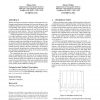Free Online Productivity Tools
i2Speak
i2Symbol
i2OCR
iTex2Img
iWeb2Print
iWeb2Shot
i2Type
iPdf2Split
iPdf2Merge
i2Bopomofo
i2Arabic
i2Style
i2Image
i2PDF
iLatex2Rtf
Sci2ools
CF
2005
ACM
2005
ACM
A case for a working-set-based memory hierarchy
Modern microprocessor designs continue to obtain impressive performance gains through increasing clock rates and advances in the parallelism obtained via micro-architecture design. Unfortunately, corresponding improvements in memory design technology have not been realized, resulting in latencies of over 100 cycles between processors and main memory. This ever-increasing gap in speed has pushed the current memory-hierarchy approach to its limit. Traditional approaches to memory-hierarchy management have not yielded satisfactory results. Hardware solutions require more power and energy than desired and do not scale well. Compiler solutions tend to miss too many optimization opportunities because of limited compile-time knowledge of run-time behavior. This paper explores a different approach that combines both approaches by making use of the static knowledge obtained by the compiler in the dynamic decision making of the micro-architecture. We propose a memory-hierarchy design based on w...
Applied Computing | CF 2005 | Memory Design Technology | Working Sets | Working-set-based Memory Hierarchy |
| Added | 13 Oct 2010 |
| Updated | 13 Oct 2010 |
| Type | Conference |
| Year | 2005 |
| Where | CF |
| Authors | Steve Carr, Soner Önder |
Comments (0)

